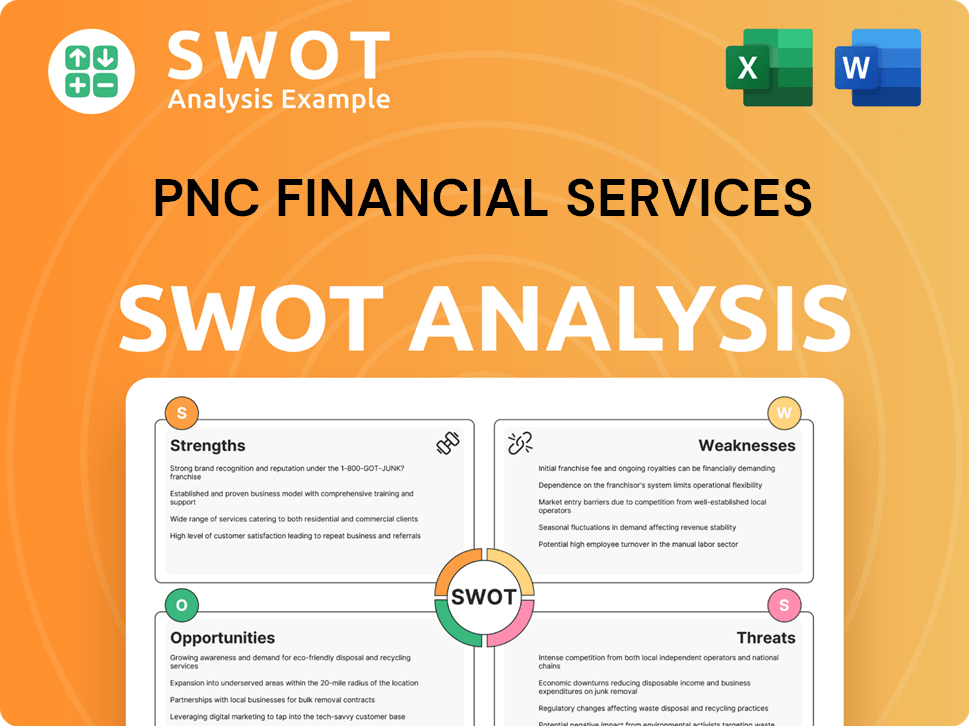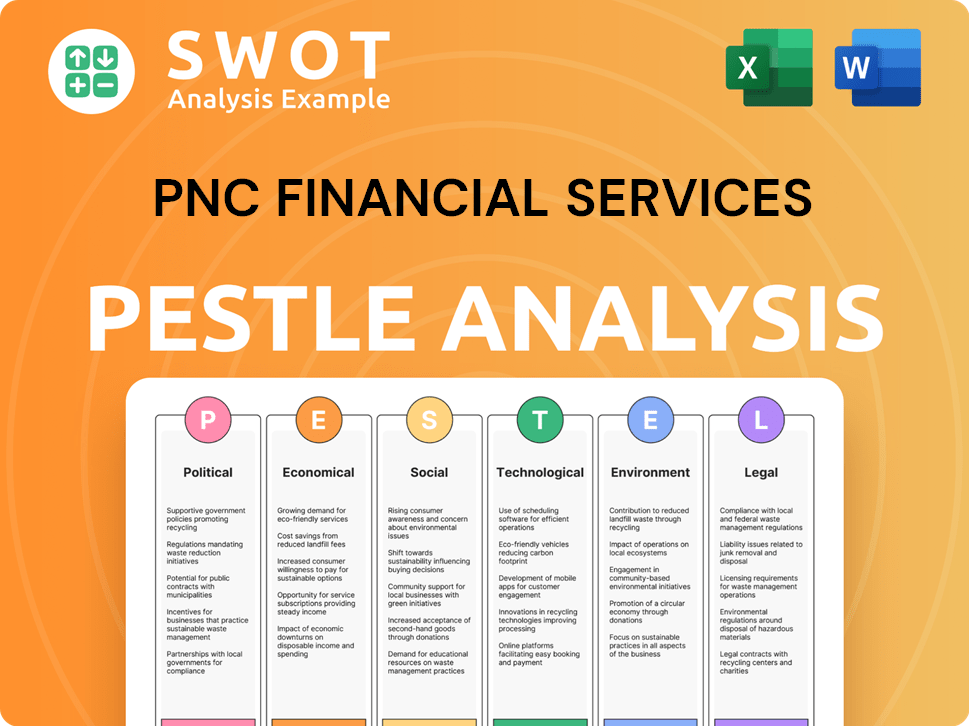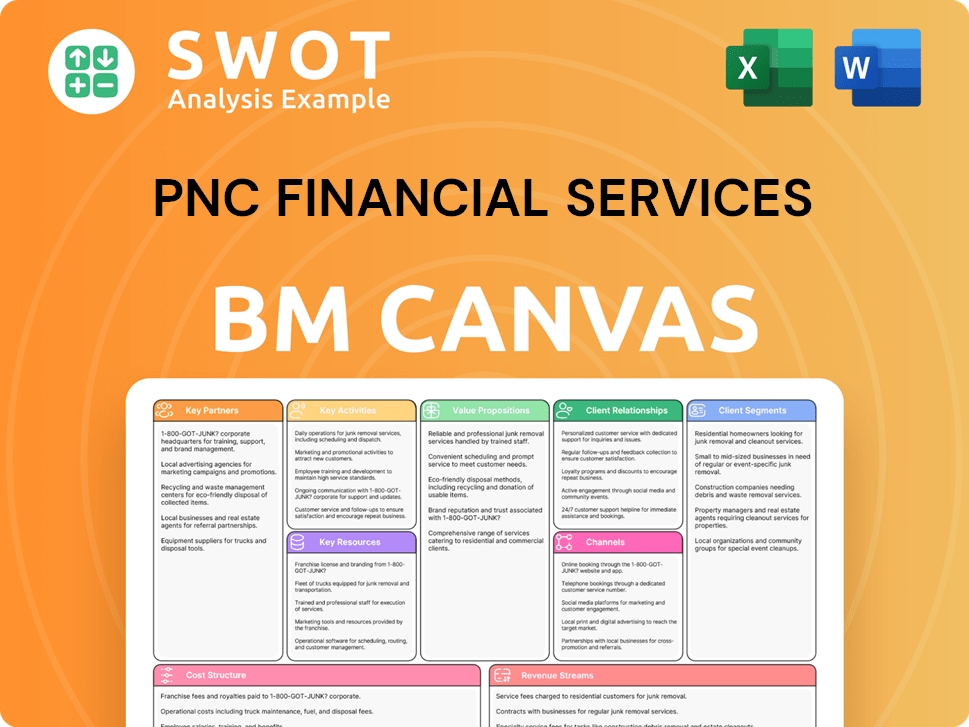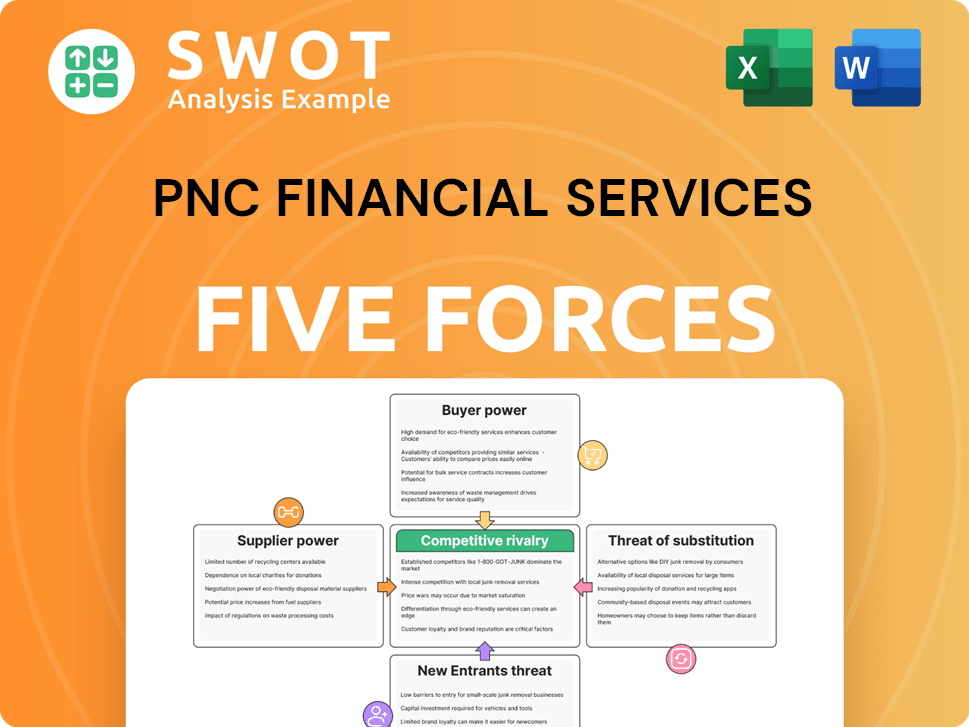PNC Financial Services Bundle
Who Does PNC Financial Services Serve?
In the ever-evolving PNC Financial Services SWOT Analysis, understanding the customer is key. PNC Financial Services' success hinges on a deep understanding of its customer demographics and target market within the competitive financial services industry. As digital banking solutions gain popularity, knowing who PNC's customers are and what they need is more crucial than ever. This knowledge shapes PNC's strategy and ensures its continued relevance and growth.

This exploration delves into PNC's customer segmentation, examining its primary and secondary target markets, including their geographic location, income levels, and financial product usage. We'll uncover the characteristics of PNC's ideal customer, and analyze how PNC strategically adapts its services to meet the diverse needs of its clientele, from individual retail customers to small businesses and wealth management clients. This market analysis will provide valuable insights into PNC's customer demographics data and its approach to serving specific customer segments.
Who Are PNC Financial Services’s Main Customers?
Understanding the customer base of PNC Financial Services involves examining its primary customer segments. The company strategically serves both consumers (B2C) and businesses (B2B), offering a diverse range of financial products and services. This dual approach allows PNC to cater to a broad spectrum of customers, from individual retail clients to large corporations and government entities, shaping its target market.
In the B2C segment, PNC focuses on a wide customer demographic, providing retail banking, brokerage services, and residential mortgage loans. PNC's commitment to expanding its physical branches, with plans to open over 100 new branches and renovate 200 existing locations by 2028, demonstrates a continued focus on serving a diverse customer base across various income levels. This initiative is part of a broader strategy to enhance customer experience and increase market share in key regions.
For its B2B segment, PNC provides specialized services tailored to corporations and government entities. These services include corporate banking, real estate finance, and asset-based lending. A key development in this area is PNC's focus on embedded finance, integrating its banking services directly into corporate clients' workflows. This digital strategy aims to enhance efficiency and strengthen customer relationships for its business clients.
PNC's customer segmentation strategy is designed to capture a broad market while also providing specialized services. The acquisition of BBVA USA in 2021 significantly expanded PNC's footprint across more than 30 states, solidifying its position as one of the largest banks in the United States. This expansion indicates a strategic move to serve a wider geographic and demographic range of customers.
- B2C (Consumer) Segment: Focuses on retail banking, brokerage services, and residential mortgage loans.
- B2B (Business) Segment: Provides specialized financial services for corporations and government entities, including corporate banking and real estate finance.
- Digital Strategy: Integrating banking services into corporate clients' workflows, such as with Workday ERP, to enhance efficiency.
- Geographic Expansion: The BBVA USA acquisition expanded PNC's reach across the United States, increasing its customer base.
PNC Financial Services SWOT Analysis
- Complete SWOT Breakdown
- Fully Customizable
- Editable in Excel & Word
- Professional Formatting
- Investor-Ready Format

What Do PNC Financial Services’s Customers Want?
Understanding the customer needs and preferences is crucial for the success of any financial institution, and for PNC Financial Services, this involves a deep dive into both retail and corporate client requirements. The financial services industry is constantly evolving, and PNC adapts by offering a blend of traditional banking services and innovative digital solutions. This approach allows PNC to cater to a diverse customer base, ensuring they meet their financial goals efficiently.
For retail customers, PNC focuses on providing accessible and convenient banking experiences. This includes maintaining a strong physical presence through its branch network, while also investing heavily in digital platforms. This approach acknowledges the importance of both in-person interactions and the convenience of online banking. By focusing on personalized financial advice and efficient transaction processing, PNC aims to build strong, lasting relationships with its customers.
Corporate and institutional clients have different needs, prioritizing streamlined operations, real-time data access, and efficient payment solutions. PNC addresses these needs by integrating its banking services directly into clients' existing workflows. This approach improves efficiency and strengthens customer relationships by allowing clients to manage payments and access financial data directly within their existing systems.
PNC aims to provide convenient access to funds, efficient transaction processing, and personalized financial advice for its retail customers. They are investing in both physical and digital channels to meet customer needs.
PNC is investing heavily in digital transformation to improve customer service, personalize financial products, and automate internal processes. This includes a new cloud-native online banking platform.
For corporate clients, PNC focuses on streamlined operations, real-time financial data access, and efficient payment solutions. Embedded finance is a key strategy.
Despite closing branches, PNC plans to open over 100 new branches and renovate 200 existing locations by 2028. Branches are seen as 'centers of advice'.
PNC is investing in AI to improve customer service and automate internal processes, aiming for a more seamless banking experience. This helps reduce operational costs.
PNC is rolling out new products and features based on customer feedback and market trends. An example is the PNC Spend Wise℠ credit card.
PNC's customer-centric approach is evident in its strategic investments and product offerings. These initiatives are designed to enhance customer experience and meet evolving market demands. This includes a focus on digital banking and personalized services.
- $1.5 billion investment by 2028 to enhance customer experience and expand market share.
- Opening over 100 new branches and renovating 200 existing locations by 2028.
- Integration with Workday ERP system through PINACLE Connect for corporate clients.
- Introduction of PNC Spend Wise℠ credit card in May 2025, offering a purchase APR reduction.
- Rolling out a new cloud-native, micro-service-based online banking platform.
PNC Financial Services PESTLE Analysis
- Covers All 6 PESTLE Categories
- No Research Needed – Save Hours of Work
- Built by Experts, Trusted by Consultants
- Instant Download, Ready to Use
- 100% Editable, Fully Customizable

Where does PNC Financial Services operate?
PNC Financial Services' geographical market presence is primarily concentrated in the Eastern United States, spanning across 27 states and the District of Columbia. This strategic focus highlights the company's dedication to both reinforcing its existing market positions and expanding into new, high-growth areas. The company's expansion strategy is a blend of physical and digital channels to serve a diverse customer base.
In February 2024, PNC announced a substantial investment of approximately $1 billion aimed at enhancing its branch network across the country. This investment includes the opening of over 100 new locations and the renovation of more than 1,200 existing branches by the end of 2028. This initiative underscores PNC's commitment to strengthening its physical presence while adapting to evolving customer preferences.
The expansion strategy includes major cities like Austin, Dallas, Denver, Houston, Miami, and San Antonio, where PNC aims to build market share. This approach allows PNC to leverage its brand recognition and customer relationships. The acquisition of BBVA USA in 2021 significantly broadened PNC's geographic reach, further solidifying its position as one of the largest banks in the United States. To understand more about the company's growth strategy, you can read Growth Strategy of PNC Financial Services.
PNC's expansion strategy emphasizes strengthening its presence in key markets. This approach allows the company to deepen its market penetration and build on existing customer relationships. The focus is on regions where PNC has already demonstrated success.
PNC addresses varying customer preferences through a dual strategy. This includes maintaining a strong physical branch presence for those preferring in-person interactions. Digital platforms cater to customers who prefer online banking.
PNC employs a balanced approach, investing in both physical and digital channels. This strategy enables the company to meet the diverse needs of its customers. The goal is to provide accessible services across its footprint.
The focus on specific, winning markets helps PNC maximize its brand recognition. This strategy allows PNC to build on its existing customer base. The company aims to deepen its market share in these targeted areas.
PNC has closed some branches due to efficiency evaluations and the popularity of online banking. In 2024, 73 branches were closed. This reflects the company's ongoing efforts to optimize its operations.
PNC Financial Services Business Model Canvas
- Complete 9-Block Business Model Canvas
- Effortlessly Communicate Your Business Strategy
- Investor-Ready BMC Format
- 100% Editable and Customizable
- Clear and Structured Layout

How Does PNC Financial Services Win & Keep Customers?
PNC Financial Services employs a comprehensive approach to acquire and retain customers, integrating both traditional and digital strategies. Their focus is on delivering personalized experiences and making strategic investments to enhance customer engagement and market share. This involves a blend of physical expansion, digital innovation, and community engagement to meet the diverse needs of their target market.
To attract new customers, PNC is expanding its physical presence, planning to open over 100 new branches and renovate 200 existing locations by 2028, representing a $1.5 billion investment. Simultaneously, they are enhancing their digital capabilities through partnerships and technology upgrades. Customer retention is prioritized through superior banking experiences, investments in technology, and a strong commitment to community support, ensuring a well-rounded approach to customer relationships.
PNC's strategy adapts to evolving customer behaviors and technological advancements, with an increasing emphasis on digital transformation and embedded finance solutions. These shifts aim to improve customer loyalty and lifetime value by providing a more comprehensive and integrated financial experience across various channels. This integrated approach is crucial for navigating the competitive landscape of the financial services industry.
PNC is investing heavily in its physical presence. The plan includes opening over 100 new branches and renovating 200 existing ones by 2028. This strategy aims to enhance customer experience and increase market share in key regions.
PNC is leveraging partnerships to expand its digital ecosystem. A key example is the September 2024 agreement with Plaid, which allows customers to securely share financial data. This enhances digital reach and provides more convenient services.
PNC is investing significantly in technology and digital solutions, including AI and cloud-based infrastructure. This is aimed at improving customer service, personalizing financial products, and automating internal processes. The goal is to create a seamless banking experience.
PNC's $88 billion Community Benefits Plan, launched in January 2022 and concluding in December 2025, supports economic empowerment. By May 2025, PNC had deployed nearly $85.5 billion, or 97% of its pledge. This fosters loyalty and positive brand perception.
PNC's customer acquisition and retention strategies are designed to cater to a diverse customer base. Understanding the Revenue Streams & Business Model of PNC Financial Services helps in appreciating the comprehensive approach PNC takes to serve its customers. This includes a mix of traditional and digital channels, personalized experiences, and strategic investments, all geared towards enhancing customer loyalty and driving long-term growth.
PNC Financial Services Porter's Five Forces Analysis
- Covers All 5 Competitive Forces in Detail
- Structured for Consultants, Students, and Founders
- 100% Editable in Microsoft Word & Excel
- Instant Digital Download – Use Immediately
- Compatible with Mac & PC – Fully Unlocked

Related Blogs
- What are Mission Vision & Core Values of PNC Financial Services Company?
- What is Competitive Landscape of PNC Financial Services Company?
- What is Growth Strategy and Future Prospects of PNC Financial Services Company?
- How Does PNC Financial Services Company Work?
- What is Sales and Marketing Strategy of PNC Financial Services Company?
- What is Brief History of PNC Financial Services Company?
- Who Owns PNC Financial Services Company?
Disclaimer
All information, articles, and product details provided on this website are for general informational and educational purposes only. We do not claim any ownership over, nor do we intend to infringe upon, any trademarks, copyrights, logos, brand names, or other intellectual property mentioned or depicted on this site. Such intellectual property remains the property of its respective owners, and any references here are made solely for identification or informational purposes, without implying any affiliation, endorsement, or partnership.
We make no representations or warranties, express or implied, regarding the accuracy, completeness, or suitability of any content or products presented. Nothing on this website should be construed as legal, tax, investment, financial, medical, or other professional advice. In addition, no part of this site—including articles or product references—constitutes a solicitation, recommendation, endorsement, advertisement, or offer to buy or sell any securities, franchises, or other financial instruments, particularly in jurisdictions where such activity would be unlawful.
All content is of a general nature and may not address the specific circumstances of any individual or entity. It is not a substitute for professional advice or services. Any actions you take based on the information provided here are strictly at your own risk. You accept full responsibility for any decisions or outcomes arising from your use of this website and agree to release us from any liability in connection with your use of, or reliance upon, the content or products found herein.